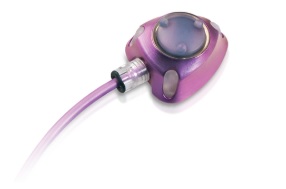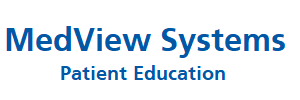
Dressing Change & Flush Port-a-Cath
A port-a-cath is a device that is usually placed under the skin in the right side of the chest. It is attached to a catheter (a thin, flexible tube) that is threaded into a large vein above the right side of the heart called the superior vena cava. A port-a-cath is used to give intravenous fluids, blood transfusions, chemotherapy, and other drugs. It is also used for taking blood samples. A port-a-cath may stay in place for weeks or months and helps avoid the need for repeated needle sticks.
A device used to draw blood and give treatments, including intravenous fluids, drugs, or blood transfusions. The port is placed under the skin, usually in the chest. It is attached to a catheter (a thin, flexible tube) that is guided (threaded) into a large vein above the right side of the heart called the superior vena cava. A port-a-cath may stay in place for many weeks or months. A needle is inserted through the skin into the port to draw blood or give fluids. Also called port.
Instructions
Demonstration Videos
Guidelines & User Manuals
Department of Health Catheter Guidelines
How often should a port-a-cath be flushed?
It is routine practice to flush ports every four to six weeks, according to the manufacturer’s recommendations, using salt solution followed heparin if needed.
IMPLANTED PORT: CARE AT HOME
What is an implanted port?
An implanted port is a device placed under the skin, usually on the upper chest, for accessing a vein. The port makes it easier to give IV medicines or fluids and take blood samples. Depending on the type of port your child has inserted, an IV may be started if your doctor orders radiographic studies with contrast.
The implanted port has 2 parts: the catheter and the reservoir. The catheter is a long, hollow tube inserted into a large vein that goes to the heart. The reservoir is the part that is accessed (a needle is put into it) for treatments. Some implanted ports have two catheters and two reservoirs, so two medicines or fluids can be given at the same time.
How is the port put in?
During surgery, the surgeon inserts the tip of the catheter under the chest skin and tunnels it into the superior vena cava, a large vein that goes to the heart. The reservoir is placed under the skin.
There will be two small incisions on the chest after surgery, one where the catheter was inserted into the vein, and one where the reservoir was placed under the skin. There will be a quarter-sized bump under the skin where the implanted port is. Your child may have soreness or discomfort at the incision sites. Pain medicine will be given as needed.
How often the port needs to be flushed depends on whether a constant infusion is being given:
- ___ once a month
- ___ every day
- ___ after infusions
- ___ normal saline
- ___ heparin 10 units/1 mL
You may also be taught how to give medicines or fluids. Home care nurses will teach you and help you become comfortable with the procedures before you do them yourself.
Only non-coring needles should be used with the implanted port. These are special needles that do not leave a hole in the reservoir of the port (see picture below). This allows the port to be accessed many times without damage. Your home infusion company will provide these special needles.
Important notes about syringes
You must use 10-mL or larger syringes. A smaller syringe may push too much pressure into the catheter and cause it to burst.
Filled syringes have an air bubble in them. Before using, squirt the air bubble out.
Every time you flush the port with normal saline or heparin, use the “push-and-pause” method: push a little solution, then pause for 1 to 2 seconds, then push a little more, pause, and so on. This method cleans the inside of the catheter. Your home care nurse will show you how to do it.
Applying anesthetic cream
If you are using anesthetic cream (such as EMLA® or ELA-Max®) to reduce the discomfort of the needle, apply it 1 to 4 hours before accessing the port. Follow the instructions that come with the cream, or see the education sheet, “Anesthetic cream.” To find the area to apply it, feel for the edges of the port with your fingers.
Can my child go swimming?
Yes, after the insertion site is healed and the port is NOT accessed. Your child may swim in a chlorinated pool or lake. Please discuss details with your child’s provider.
Preventing infection
Implanted ports are helpful for taking care of your child; however, they can increase the risk of infections when bacteria grow in the device and travel to the bloodstream. This is called a Central Line Associated Blood Stream Infection or CLABSI. A CLABSI can be serious and life threatening.
Fortunately there are steps we can take to prevent CLABSIs. The most important step is hand washing.
At the hospital
Members of your health care team take steps to prevent infection such as washing their hands and weaing gloves. Daily CHG bath treatments are used while in the hospital. Parents and patients also have a role to play in preventing CLABSIs:
- Wash your hands with soap and water, or use alcohol-based hand rub found in each room. Hand hygiene is required:
- When you enter and leave your child’s room;
- Before and after you prepare food, eat, or feed your child;
- Before and after you use the bathroom or change a diaper.
- Ask your child’s visitors to wash their hands when they enter and exit your child’s room.
- Do not allow visitors to touch the IV tubing.
- Watch your nurses and doctors to make sure they wash their hands before and after handling IV tubing. Do not be afraid to remind them to wash their hands!
- Keep any IV tubing out of the diaper area when changing the diaper, and do not allow your child to suck on tubing.
At home
- It is very important to prevent infection, which might require removal of the port. The nurse will show you how to keep your supplies sterile, so no germs will enter the port and cause an infection.
- A thin, medicated sponge (BioPatch®) will also be placed around the needle insertion site if your child’s port will be in use greater than 24 hours.
- Cleanliness is a must! Each time you give a medicine or flush the port, follow these steps:
- Prepare a clean work area by cleaning a solid surface with a disinfectent cleanser (such as Lysol® or another brand).
Wash your hands well, using one of the following methods:
- Use an alcohol-based hand sanitizer (Purel® or another brand) according to directions.
- If sanitizer is not available, wash your hands with antibacterial soap for at least 15 seconds, rubbing all surfaces briskly, including between your fingers and under your fingernails. Use a paper towel or clean hand towel to dry your hands, and then use the towel to turn off the faucet.
- Before each time you flush or put any medicine into the IV tubing, put on non- sterile gloves and scrub the injection cap for 30 seconds with a fresh chlorhexidine wipe, using friction. Let the cap dry. Do not fan or blow on it.
- Perform hand washing before caring for your child’s port. This includes: administering medication, cap change, accessing, dressing change, remove the needle or any time handling the port.
If your therapy requires on-going supplies please see “How do I order supplies?” section below.
How do I order supplies?
Your supplies will be ordered from a medical equipment supply company or home care pharmacy. The first order will be delivered to the hospital or your home. Check with your nurse to be sure you have everything you need. You will receive the number to call when you need to order supplies in the future.
Accessing the port
- Prepare the work surface.
- Wash your hands.
- Gather supplies:
- chlorhexidine applicator
- heparin syringe
- sterile normal saline sryinge
- injection cap
- sterile gloves
- sterile drape
- masks (3)
- non-coring port needle with tubing, size length
- transparent dressing, if you will leave the port needle in place
- medicated disc, Biopatch®, if port will be in use greater than 24 hours
- a sharps container for needles
- Check the labels of the normal saline and heparin syringes before giving them.
- Normal saline and heparin syringes are good until the expiration date. Throw it away sooner if you see sediment in it or if you question its cleanliness.
- If anesthetic cream (such as EMLA® or ELE-Max®) used wipe off with clean cloth or paper towel.
- Prepare the port needle and tubing
- Wash your hands.
- Put on mask. Masks should be worn by you, your child, and helper.
- Open sterile drape. Only touch the outside edges to keep the middle section sterile.
- Open supplies onto sterile drape without touching any of the items inside the packages or touching the packages to the sterile drape.
- Put on sterile gloves. After sterile gloves are on, only touch supplies on your sterile drape.
- Screw the injection cap into the end of the port needle tubing.
- Attach the sterile normal saline syringe to the injection cap.
- Flush the sterile normal saline through the injection cap and tubing to the end of the port needle until a drop appears.
- Leave the sterile normal saline syringe connected to the injection cap.
- Clamp the tubing.
- Clean the port site
- Prepare the applicator, sepps, or swab as directed.
- Scrub the site with one chlorhexidine applicator for 30 seconds, using friction in a back and forth pattern, up and down, sideways, and diagonal pattern.
- Allow skin to completely dry (approximately 60 seconds). Do not blow on or fan the area.
- Place the needle into the port
- Hold the port needle by the handle in one hand. Remove the needle cover.
- If instructed to do so, place Biopatch® around needle prior to accessing, with white side in contact with the skin.
- Hold the port steady with other hand by holding the outer edges of the port. Be careful not to touch the area where the needle will go into the port.
- Hold the needle at a 90-degree angle, aim for the center of the port, and push the needle firmly through the skin and the port until it touches the back of the port chamber.
- Unclamp the tubing.
- Pull back on the syringe plunger to check for a blood return before injecting any medicines or fluids.
- If there is a blood return, flush with the normal saline. Continue with your planned procedure.
- If there is no blood return, and you think you are in the right place, gently try to flush with 2 or 3 ml of normal saline. If you are able to flush easily, pull back on the syringe plunger again to see if there is a blood return. If there is still no blood return, stop. Call the home care nurse.
- Covering the port with the dressing
- Apply skin prep where the edges of the dressing will be. This protects the skin.
- Apply transparent dressing over the needle and tubing.
Quick Reference — Preparing pre-filled syringes:
ALL pre-filled syringes have an air bubble in them (normal saline, heparin, medicine). Remove the tip cover from the syringe and point the syringe upward , pull slightly back on plunger and squirt the air bubble out before using.
Giving medicines and flushing the implanted port
If you have just accessed the port, go to step 9.
- Prepare the work surface.
- Wash your hands.
- Gather supplies:
- chlorhexidine wipes
- heparin syringe
- normal saline syringe (2)
- non-sterile gloves
- medicines you will be giving, if any
- Check the labels of the normal saline and heparin syringes, and any other medicines or fluids before giving them. Make sure they are the right medicines.
- A medicine good until the expiration date. Throw it away sooner if you see sediment in it or if you question its cleanliness. If you throw a medicine away, be sure to call the home care pharmacy for replacement.
- Put on non-sterile gloves.
- Scrub the injection cap with a chlorhexidine wipe for 30 seconds and let it dry.
- Attach the normal saline syringe tip into the injection cap.
- Unclamp tubing.
- Flush with normal saline using the push- and-pause method. When syringe is empty, remove it from the injection cap.
If you are not giving medicines at this time, go to step 17.
If you are giving medicines, scrub injection cap with a new chlorhexidine wipe for 30 seconds and let it dry.
- Connect the medicine and give as instructed by your home care nurse. If you are giving an infusion, go to “Leaving the needle in place for an infusion”
- After giving the medicine or infusion disconnect the medicine from the injection cap.
- Scrub injection cap with a new chlorhexidine wipe for 30 seconds and let it dry.
- Attach normal saline syringe and flush using the push-and-pause method. When syringe is empty, remove it from the injection cap.
- Scrub the injection cap with a new chlorhexidine wipe for 30 seconds and let it dry
- Attach heparin syringe and flush using the push-and-pause method. When syringe is empty, remove it from the injection cap.
- Clamp the IV tubing.
- Leaving the needle in place for an infusion
- After accessing the port and flushing with saline, remove the normal saline syringe.
- Follow directions for IV infusion provided by your home care nurse.
- Change the port needle every 7 days.
Quick reference:
- Flush with normal saline.
- Give the medicine or fluid.
- Flush with normal saline.
- Flush with heparin.
- Removing the port needle
- Wash your hands.
- Put on non-sterile gloves.
- Scrub the injection cap with a new chlorhexidine wipe for 30 seconds and let it dry
- Attach heparin syringe, unclamp tubing. Flush using the push-and-pause method. When syringe is empty, remove it from the injection cap.
- Hold the port steady with the fingers of one hand.
- With your other hand, hold the port needle, and put one finger on the tip of the safety arm.
- Lift the safety arm straight back until it clicks. This removes the needle from the port and covers the tip of the needle.
- If bleeding occurs, apply pressure with sterile gauze until it stops.
- Apply a bandage if needed.
- Cleaning up
- Put the needle and the tubing into the sharps container. Put used syringes into your regular trash, unless blood is in them. If they are soiled with blood, use a sharps container.
Do not overfill the sharps container. Disposal varies depending on the area you live in. Some communities have a household sharps collection program. To find out what you should do, check with your garbage collection company, pharmacy, or clinic.
Who and when should I call for help?
Call home care if:
- difficult to flush or give medicine
- no blood return from the port
Call the clinic if:
- temperature higher than 101.5° F (38.6° C)
- redness, swelling, drainage, or pain at the incision site
- redness, swelling, drainage, or pain at the port site
Related Devices
Central-line-or-picc-line-dressing-change
Central Line Dressing Change A central line (PICC, port, Hickman or other tunneled catheter) dressing change is Read more...
How to prepare and administer TPN Instructions
TPN Administered TPN administration into a vein, generally through a PICC (peripherally inserted central catheter) Read more...
Flushing a port a cath Instructions
Flushing a Port a Cath Normal saline is used to flush fluids through, a heparinized saline solution Read more...
Dressing Change & Flush Port-a-Cath Instructions
Dressing Change & Flush Port-a-Cath A port-a-cath is a device that is usually placed under the skin in Read more...
Access Port-a-cath Instructions
Port-a-cath A port-a-cath, also referred to as a port, is an implanted device which allows Read more...
Central Line Dressing Change Instructions
Central Line Dressing Change A central line (PICC, port, Hickman or other tunneled catheter) dressing change is Read more...
Caring for Peripherally Inserted Central Catheter (PICC)
Peripherally inserted central catheter (PICC) PICC stands for Peripherally Inserted Central Catheter. It’s a type of central Read more...
Bard Medical STATLOCK® PICC Plus Stabilization Device
StatLock® PICC Plus Stabilization Device The StatLock® PICC Plus Stabilization Device offers great versatility and ease of Read more...
Biopatch – PICC line Dressing Change
PICC line dressing change (Biopatch) Shows how to set up the new dressing change tray/kit Read more...
PICC line Blood Draw Instructions
Central Line Blood Draw Central lines are IV's which allow medications to be given into large veins in Read more...
Patient Learning Center

